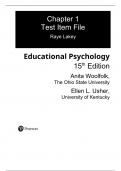Chapter 1
Test Item File
Raye Lakey
R
U
Educational Psychology
SE
15 Edition
th
ISAnita Woolfolk,
O
The Ohio State University
N
N
Ellen L. Usher,
O
University of Kentucky
C
ED
M
,This work is protected by United States copyright laws and is provided solely
for the use of instructors in teaching their courses and assessing student
learning. Dissemination or sale of any part of this work (including on the
World Wide Web) will destroy the integrity of the work and is not permitted.
The work and materials from it should never be made available to students
except by instructors using the accompanying text in their classes. All
recipients of this work are expected to abide by these restrictions and to
honor the intended pedagogical purposes and the needs of other instructors
who rely on these materials.
R
Product Manager: Drew Bennett
Content Analyst: Rebecca Fox-Gieg
U
Content Producer: Janelle Rogers
SE
Copyright © 2023, 2019, 2016 by Pearson Education, Inc. or its affiliates. All Rights Reserved.
Manufactured in the United States of America. This publication is protected by copyright, and
permission should be obtained from the publisher prior to any prohibited reproduction, storage
in a retrieval system, or transmission in any form or by any means, electronic, mechanical,
IS
photocopying, recording, or otherwise. For information regarding permissions, request forms,
and the appropriate contacts within the Pearson Education Global Rights and Permissions
department, please visit www.pearsoned.com/permissions/.
O
PEARSON are exclusive trademarks owned by Pearson Education, Inc. or its affiliates in the
N
U.S. and/or other countries.
N
Unless otherwise indicated herein, any third-party trademarks, logos, or icons that may appear
in this work are the property of their respective owners, and any references to third-party
trademarks, logos, icons, or other trade dress are for demonstrative or descriptive purposes
O
only. Such references are not intended to imply any sponsorship, endorsement, authorization,
or promotion of Pearson’s products by the owners of such marks, or any relationship between
C
the owner and Pearson Education, Inc., or its affiliates, authors, licensees, or distributors.
ED
M
ii
Copyright © 2023, 2019, 2016 by Pearson Education, Inc. All rights reserved.
, Table of Contents
Chapter 1: Learning, Teaching, and Educational Psychology
Learning Outcome Quizzes 1
Application Exercises 13
Test Items 16
Test Answer Key 21
Licensure Quizzes 26
R
U
SE
IS
O
N
N
O
C
ED
M
iii
Copyright © 2023, 2019, 2016 by Pearson Education, Inc. All rights reserved.
, Chapter 1: Learning, Teaching, and Educational Psychology
Chapter 1 Learning Outcome Quizzes
Learning Outcome 1.1: Describe the challenges facing teachers today, including increasing
student diversity, requirements of the Every Student Succeeds Act, the continuing impact of
testing and accountability for teachers and students, and the emphasis on social and emotional
learning.
[Q1]
R
Addison has several years of experience teaching third graders from diverse backgrounds. As
one student struggles to complete a math task, Addison wonders why the task seems so
U
difficult. She gives the student a hint about solving the task, but the hint doesn’t help. She
begins to reteach the basic skill required for the task. She reminds herself with certainty that she
SE
can help the student understand and succeed. Which of the teacher’s behaviors is most directly
associated with a personal sense of efficacy?
1. She wonders why the task seems so difficult for the student
2. She gives the student a hint about solving the task
IS
3. She begins to reteach the basic skill required for the task
O
4. She reminds herself with certainty that she can help the student [correct]
[Feedback for Answer Choice 1]
N
A teacher may wonder about the level of difficulty of a task and yet lack a sense of efficacy.
N
[Feedback for Answer Choice 2]
A teacher’s hint may help a student learn, but it is not a sign of the teacher’s sense of efficacy.
O
[Feedback for Answer Choice 3]
C
Reteaching a skill may help a student learn, but it is not a sign of the teacher’s sense of efficacy.
[Feedback for Correct Answer 4]
ED
A teacher’s belief that he or she can reach even the most difficult students and help them learn
is evidence of the teacher’s sense of efficacy.
[Q2]
M
According to the Every Student Succeeds Act (ESSA), which of the following schools is
considered a failing school?
1. A school in which students’ scores are in the bottom 12% of test scores
2. A school that graduates only 60% of its students [correct]
3. A school in which Native American students underperformed last year
4. A school in which African American students underperformed last year
1
Copyright © 2023, 2019, 2016 by Pearson Education, Inc. All rights reserved.




